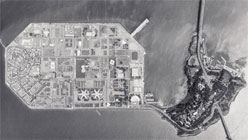On the sixth floor of San Francisco’s Main Library, in the Skylight Gallery, a small exhibition organized by the Treasure Island Museum Association attempts to tell the story of arts in the 1939-1940 Golden Gate International Exposition. The Magic City is a meager collection of four vitrines of ephemera, a few pieces of art, several chunks of wall text, and five Pan American Airways posters advertising travel to South America, all gussied up with a backdrop of gold and blue gauze. While underwhelming, it accurately depicts the status of the Treasure Island Museum at large. The exhibition hints at a larger, richer collection buried in storage, inaccurately represented by the few items at hand.
The Treasure Island Museum’s story is one of bureaucratic limbo. Founded in 1976, it showcased the island’s history from fair site to naval base. Various displays charted life in the seafaring services (Navy, Marine Corps, and Coast Guard), the splendor of the World’s Fair, and the “glamorous” Pan Am China Clippers with service across the Pacific. It always existed within what seemed like borrowed space: formerly occupying the lobby of Treasure Island’s Building One, headquarters of the Navy in San Francisco.
That is, until 1997, when the Navy shut down operations on Treasure Island and began transferring the land over to the City of San Francisco. The museum’s collection was placed in storage with only a few items leaving for the periodic historical society gathering, Treasure Island Flea Market, or small-scale exhibition at the public library.
Which brings us to The Magic City. The exhibition focuses on two aspects of art within the World’s Fair. The first half of the exposition exhibited works borrowed from around the world, allowing locals and visitors to see works of art they had previously only glimpsed in print. When these works were returned to their home institutions, the fair opened the “Art in Action” program, for which artists and craftspeople made work within an enclosure in the Palace of Fine and Decorative Arts (an airplane hangar). Visitors could gaze at them, zoo-like, while they painted, sculpted, and threw ceramics.
The most notable participating artist was Diego Rivera, who worked on the mural Pan American Unity, commissioned by and now housed at City College of San Francisco. Unfortunately, The Magic City contains no documentation of this mural. One undated linoleum cut by Rivera’s assistant, Emmy Lou Packard, is shown, but this provides little aid in the visualization of what surely must have been a spectacle: Rivera and his two assistants working on ten panels measuring 22 by 74 feet in total size, completing the work two months after the fair’s close in the cavernous and by then empty airplane hangar, without heat.


